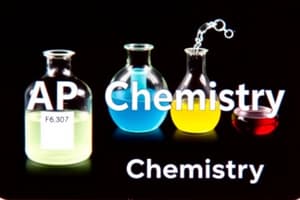Podcast
Questions and Answers
Which of the following lists the samples in order of increasing number of moles in the sample?
Which of the following lists the samples in order of increasing number of moles in the sample?
- NaCl < KBr < KCl
- KCl < NaCl < KBr
- NaCl < KCl < KBr
- KBr < KCl < NaCl (correct)
In addition to Avogadro's number, which of the following must the student know to determine the number of molecules in a pure solid sample?
In addition to Avogadro's number, which of the following must the student know to determine the number of molecules in a pure solid sample?
- Molar mass of the compound (correct)
- Density of the compound
- Temperature of the sample
- Volume of the sample
Which numerical expression gives the number of particles in 2.0g of Ne?
Which numerical expression gives the number of particles in 2.0g of Ne?
(2.0g/20.18 g/mole)(6.0x10^23 particles/mol)
The mass spectrum of the element Sb is most likely represented by which of the following?
The mass spectrum of the element Sb is most likely represented by which of the following?
Which element has the mass spectrum represented above?
Which element has the mass spectrum represented above?
The peak at 26 amu in the mass spectrum represents an isotope of which element?
The peak at 26 amu in the mass spectrum represents an isotope of which element?
What is the formula unit of each compound with different ionic compounds containing copper and chlorine?
What is the formula unit of each compound with different ionic compounds containing copper and chlorine?
Which sample has the higher purity based on percent by mass of chlorine?
Which sample has the higher purity based on percent by mass of chlorine?
Which has the greater molar mass, X or Z?
Which has the greater molar mass, X or Z?
What information could be used to determine which mixture has the higher proportion of KCl?
What information could be used to determine which mixture has the higher proportion of KCl?
Which columns provide all the information necessary to determine the mole ratio of Ca to Mg in the rock?
Which columns provide all the information necessary to determine the mole ratio of Ca to Mg in the rock?
What quantities are needed to determine if the sample is pure MgCl2?
What quantities are needed to determine if the sample is pure MgCl2?
Which ground-state electron configuration represents the atom with the lowest first-ionization energy?
Which ground-state electron configuration represents the atom with the lowest first-ionization energy?
What is the ground-state electron configuration of the F− ion?
What is the ground-state electron configuration of the F− ion?
What represents the ground-state electron configuration for an atom of selenium?
What represents the ground-state electron configuration for an atom of selenium?
Which electron configuration is consistent with the complete photoelectron spectrum?
Which electron configuration is consistent with the complete photoelectron spectrum?
What observation would provide evidence that the spectrum is consistent with the atomic model?
What observation would provide evidence that the spectrum is consistent with the atomic model?
How is the photoelectron spectrum consistent with the electron shell model of the atom?
How is the photoelectron spectrum consistent with the electron shell model of the atom?
Flashcards
Moles and Sample Masses
Moles and Sample Masses
The number of moles in a sample is directly proportional to the mass of the sample and inversely proportional to the molar mass.
Mass Spectrum Analysis
Mass Spectrum Analysis
The mass spectrum of an element shows the relative abundance of its isotopes, which are atoms of the same element with different numbers of neutrons.
Ionic Compound Analysis
Ionic Compound Analysis
The formula unit of an ionic compound represents the simplest ratio of ions in the compound.
Mixtures and Composition
Mixtures and Composition
Signup and view all the flashcards
Electron Configurations
Electron Configurations
Signup and view all the flashcards
Photoelectron Spectroscopy
Photoelectron Spectroscopy
Signup and view all the flashcards
Mole Order
Mole Order
Signup and view all the flashcards
Number of Particles
Number of Particles
Signup and view all the flashcards
Isotopes in Mass Spectrum
Isotopes in Mass Spectrum
Signup and view all the flashcards
Mass Number
Mass Number
Signup and view all the flashcards
Ionic Compound Formula
Ionic Compound Formula
Signup and view all the flashcards
Percent by Mass
Percent by Mass
Signup and view all the flashcards
Mole Ratio
Mole Ratio
Signup and view all the flashcards
Purity
Purity
Signup and view all the flashcards
Ground State Electron Configuration
Ground State Electron Configuration
Signup and view all the flashcards
Photoelectron Spectroscopy and Electron Configuration
Photoelectron Spectroscopy and Electron Configuration
Signup and view all the flashcards
First Ionization Energy
First Ionization Energy
Signup and view all the flashcards
Nitrogen's Photoelectron Spectrum
Nitrogen's Photoelectron Spectrum
Signup and view all the flashcards
Study Notes
Moles and Sample Masses
- In comparing 1g samples of NaCl, KBr, and KCl, the order of increasing number of moles is KBr < KCl < NaCl.
- To determine the number of molecules in a pure solid compound, knowledge of molar mass and mass of the sample is essential.
- The calculation for the number of particles in 2.0g of Ne involves using the formula: (2.0g/20.18 g/mole) × (6.0 × 10^23 particles/mol).
Mass Spectrum Analysis
- The mass spectrum of antimony (Sb) shows peaks at atomic mass units (amu) 121 and 123.
- Molybdenum (Mo) is identified as having a mass spectrum aligning with these amu values.
- The presence of a peak at 26 amu in a mass spectrum indicates an isotope of magnesium (Mg) with 14 neutrons.
Ionic Compound Analysis
- An elemental analysis of two copper-chlorine ionic compounds can help determine their formula units based on differences observed.
- Measuring the percent by mass of chlorine in two NaCl samples helps identify which has higher purity if KCl is the only contaminant.
- Comparing the mass of residues after heating two unknown alkali metal chlorates allows determination of which compound has a greater molar mass between X and Z.
Mixtures and Composition
- Analysis of two 10g mixtures of NaCl and KCl can determine which has a higher proportion of KCl by assessing the mass of Cl in each.
- The mole ratio of calcium to magnesium in a mixed carbonate rock is derived from specific columns in a lab analysis table (3, 4, 6, 7).
- For assessing purity in a 5.0g sample of MgCl2, knowledge of both the mass of Mg and the mass of Cl is crucial.
Electron Configurations
- The lowest first-ionization energy corresponds to the ground-state electron configuration of 1s²-2s²-2p⁶-3s¹.
- The electron configuration of the F⁻ ion is represented as 1s²-2s²-2p⁶.
- Selenium's ground-state electron configuration is illustrated as 1s²-2s²-2p⁶-3s²-3p⁶-4s²-3d¹⁰-4p⁴.
Photoelectron Spectroscopy
- An element's complete photoelectron spectrum can be consistent with the electron configuration of 1s²-2s²-2p⁶-3s²-3p³.
- If an element tends to form ions with a +1 charge, this provides evidence that its spectrum aligns with known atomic models.
- In the case of nitrogen, its photoelectron spectrum demonstrates that electrons in the 2p sublevel have the lowest binding energy.
Studying That Suits You
Use AI to generate personalized quizzes and flashcards to suit your learning preferences.
Description
Test your knowledge of key concepts in AP Chemistry with these quizzes covering Units 1-4 and Unit 6. Each question dives into core ideas, such as molar relationships and the properties of compounds. Perfect for reinforcing your understanding and exam preparation.




